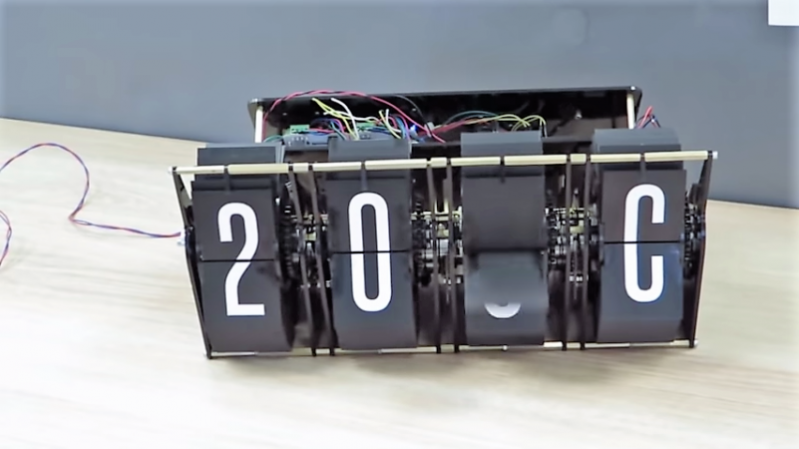There’s little doubt about the charms of a split-flap display. Watching a display build up a clear, legible message by flipping cards can be mesmerizing, whether on a retro clock radio from the 70s or as part of a big arrival and departure display at an airport or train station. But a weather station with a split-flap display? That’s something you don’t see often.
We usually see projects using split-flap units harvested from some kind of commercial display, but [gabbapeople] decided to go custom and build these displays from the ground up. The frame and mechanicals for each display are made from laser-cut acrylic, as are the flip-card halves. Each cell can display a full alphanumeric character set on 36 cards, with each display driven by its own stepper. An Arduino fetches current conditions from a weather API and translates the description of the weather into a four-character code. The codes shown in the video below seem a little cryptic, but the abbreviation list posted with the project makes things a bit clearer. Bonus points if you can figure out what “HMOO” is without looking at the list.
We like the look and feel of this, but we wonder if split-flap icons might be a neat way to display weather too. It seems like it would be easy enough to do with [gabbapeople]’s detailed instructions. Or you could always look at one of the many other custom split-flap displays we’ve featured for more inspiration.
















Interesting, good value for power efficiency since could be easily configured to operate for very short time only and the motion sound great as alert too.
I’d like to grab the earlier large airport displays and configure them for stock market trading, I’m into so many slow moving low cap stocks it seems not worth powering up the other panels… There are heaps of other places where this could be ideal and novel for slow moving data where power considerations are an issue And where a gentle sound on change gently alerts those in the vicinity. In one case I have in mind is large array battery cell testing already on the drawing board for the coming Australian autumn…
Nice post, thanks :-)
I have a cheap Chinese split-flap click on my desk. The louder ‘clat’ on the hour works surprisingly well as a subliminal trigger.
Hazy Moonlight?
I love the display!
A split flap display might be cool as a status display for servers or build systems or trees or something. Doesn’t change status very often (as a rule) and the noise from when it does change would alert someone that something is up.
“What is this gibberish on the display? Oh, display server went down”
Very well done project. Nice step by step directions with a video to show it all done.
I am wondering what the advantage of the split flap display has over the old “slot machine” type displays that old pinball machines had in them. To me is seems simpler to index the wheel reliably than it does to release just one flap. I guess you can pack the flaps in tighter than the wheels if you need high density. Did anybody ever make a wheel type display that was flexible so only the displayed digit was exposed and the rest was coiled up? Cool build regardless.
The main difference is the volume required. Train stations used split flap displays because the height of the modules isn’t much more than the character height, allowing displays to be stacked for a high information density display. Furthermore, the number of different characters or messages on a split flap display is limited only by the thickness of the flaps and how precisely you can position the wheels, so they work well for a compact alphanumeric display. A wheel with a 1″ font capable of displaying 64 characters would have a circumference of 64″, or diameter of 20″.
That is, a wheel with characters printed on its perimeter.
That is really a pretty implementation.